

Beyond the Brush: Inventive Use of Media for Painting Students. Last updated February 8th, 2017 This article outlines unusual painting and drawing techniques that are useful for creating exciting sketchbook pages, grounds, textural layers and adding tone and colour to an artwork.
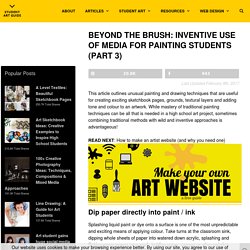
While mastery of traditional painting techniques can be all that is needed in a high school art project, sometimes combining traditional methods with wild and inventive approaches is advantageous! Dip paper directly into paint / ink Splashing liquid paint or dye onto a surface is one of the most unpredictable and exciting means of applying colour.
Take turns at the classroom sink, dipping whole sheets of paper into watered down acrylic, splashing and flicking water across your work: holding paper, canvas or other painting surfaces in the air and letting the paint run down. Paint using drips Gravity can be a superb painting tool. There was complete silence … Pollock looked at the painting. Paint with your body Students should never be afraid of mess. Painting on Grounds: Inventive uses of media for Art students. Last updated February 8th, 2017 It has always amazed me how few high school Art students use a ‘ground’ in their artwork.
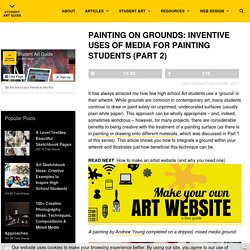
While grounds are common in contemporary art, many students continue to draw or paint solely on unprimed, undecorated surfaces (usually plain white paper). This approach can be wholly appropriate – and, indeed, sometimes wondrous – however, for many projects, there are considerable benefits to being creative with the treatment of a painting surface (as there is in painting or drawing onto different materials, which was discussed in Part 1 of this series).
This article shows you how to integrate a ground within your artwork and illustrates just how beneficial this technique can be. A painting by Andrew Young completed on a dripped, mixed media ground: What is a ‘ground’? Short for ‘background’, a ground is the very first layer of paint (or other wet medium) applied to an artwork. Using a ground has several practical advantages, as well as some important aesthetic ones. How to make your Art Project exciting: creative mixed media. Last updated February 8th, 2017 Sometimes even highly able Painting students feel stuck in a rut.

If your IGCSE or A Level Art Coursework project feels stagnant, repetitive, or downright boring, you may benefit from increased experimentation with media, techniques and processes (the ideas listed below are also perfect for using in an A Level or GCSE Art sketchbook). While it is important to remember that art-making mediums should be used in a way that supports your ideas, there are times when a dash of unpredictability and thinking-outside-the-box can help. Paint on something interesting Time and time again I see students who paint or draw on white cartridge paper and nothing else.
Draw on coloured paper The first thing you can do is embrace papers of other colours. Dark colours can be great for drawing on with light mediums; mid-tone papers (those that are a ‘medium’ tone – not too dark and not too light) are also excellent. Embrace textured paper Integrate newspaper cuttings. How to develop your ideas: A Level Art Coursework development. Last updated February 8th, 2017 Many high school Art students (such as those studying AS or A2 Level Art & Design) must present a Coursework or Exam portfolio that shows development.
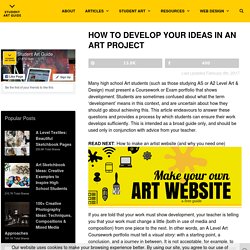
Students are sometimes confused about what the term ‘development’ means in this context, and are uncertain about how they should go about achieving this. This article endeavours to answer these questions and provides a process by which students can ensure their work develops sufficiently. This is intended as a broad guide only, and should be used only in conjunction with advice from your teacher. If you are told that your work must show development, your teacher is telling you that your work must change a little (both in use of media and composition) from one piece to the next. As an example, the following process was undertaken by my A Level Painting students (this process could be easily modified for Graphic Design, Photography or Sculpture) during the course of the year: 1. 2. 3. 4. 5. 6.
Still unsure? Why some Art students almost never get high grades. Last updated February 8th, 2017 Do you fall short of your potential and gain poor, mediocre or inconsistent results?
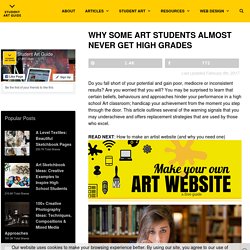
Are you worried that you will? You may be surprised to learn that certain beliefs, behaviours and approaches hinder your performance in a high school Art classroom; handicap your achievement from the moment you step through the door. This article outlines several of the warning signals that you may underachieve and offers replacement strategies that are used by those who excel.
Warning Sign 1: You find your Art topic boring Even the most dull and uninspiring subject-matter can be turned into something wondrous. Note: Producing great work is just as difficult given a narrow topic as a wide one. Warning Sign 2: You forget to bring your things to class Those who regularly leave work or equipment at home, set themselves up for failure. Warning Sign 3: You can’t keep up with the pace Managing the workload in an Art-related subject is hard. Final Words Final Words. The Top 10 Mistakes Made by Art Students. Last updated April 14th, 2018 A Spanish translation of this article is available here: Traducción Española In my seven years of teaching, I have assessed over one thousand Painting / Fine Art student folios.
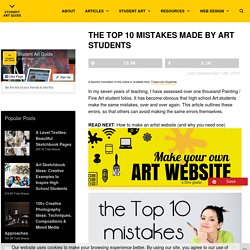
It has become obvious that high school Art students make the same mistakes, over and over again. This article outlines these errors, so that others can avoid making the same errors themselves. In no particular order, the mistakes are as follows: Art Sketchbook Ideas: Creative Examples to Inspire High School Students. Last updated November 29th, 2018 This article provides tips and guidance to help you produce an outstanding high school sketchbook.

It contains an online collection of sketchbook pages from different qualifications from around the world, including IGCSE / GCSE Art, A Level Art, VCE Studio Arts, NCEA Level 3 Scholarship and IB Visual Art. Many of the sketchbook pages shown below are from projects that achieved full marks. These examples illustrate a wide range of possible approaches to sketchbook content, annotation, and page layout.
Top in the World: Stunning Self-Portraits by an A Level Art Student. Last updated February 8th, 2017 This outstanding Painting and Related Media project was completed by Abby Hope Skinner while studying A Level Art and Design at the International School of Paphos, Cyprus.
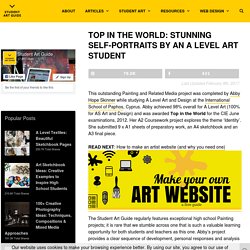
Abby achieved 98% overall for A Level Art (100% for AS Art and Design) and was awarded Top in the World for the CIE June examinations, 2012. Her A2 Coursework project explores the theme ‘Identity’. She submitted 9 x A1 sheets of preparatory work, an A4 sketchbook and an A3 final piece. International GCSE Art Sketchbook Examples. Last updated February 8th, 2017 The A3 sketchbook examples shown in this blog post were created by my sister Heather Garland (aged seventeen) and I, prior to my first year of teaching IGCSE Art and Design (the International equivalent of GCSE Art, assessed by Cambridge University).
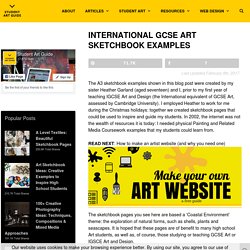
I employed Heather to work for me during the Christmas holidays: together we created sketchbook pages that could be used to inspire and guide my students. In 2002, the internet was not the wealth of resources it is today: I needed physical Painting and Related Media Coursework examples that my students could learn from. The sketchbook pages you see here are based a ‘Coastal Environment’ theme: the exploration of natural forms, such as shells, plants and seascapes.